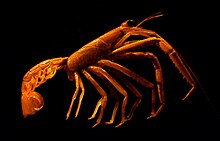| Glypheoidea Temporal range: Permo-Triassic–Recent PreꞒ Ꞓ O S D C P T J K Pg N | |
|---|---|

| |
| Neoglyphea inopinata | |
| Scientific classification | |
| Domain: | Eukaryota |
| Kingdom: | Animalia |
| Phylum: | Arthropoda |
| Class: | Malacostraca |
| Order: | Decapoda |
| Suborder: | Pleocyemata |
| Infraorder: | Glypheidea |
| Superfamily: | Glypheoidea Winkler, 1883 |
The Glypheoidea (containing the glypheoid lobsters), is a group of lobster-like decapod crustaceans which forms an important part of fossil faunas, such as the Solnhofen limestone. These fossils included taxa such as Glyphea (from which the group takes its name), and Mecochirus, mostly with elongated (often semichelate) chelipeds. This group of decapods is a good example of a living fossil, or a lazarus taxon, since until their discovery in the 1970s, the group was considered to have become extinct in the Eocene. The superfamily Glypheoidea comprises five families. The two extant species, Neoglyphea inopinata and Laurentaeglyphea neocaledonica, are both in the family Glypheidae.
Prehistoric abundance
The first animals attributable to the Glypheoidea appeared in the Permo-Triassic. They were abundant in the Jurassic, but declined from the Cretaceous to the Eocene.
Extant taxa
The Glypheoidea was originally considered to be a purely fossil group. That opinion had to be altered when a single male specimen was discovered in the collections of the Smithsonian Institution in 1975. It had been caught off the Philippines in 1908 and preserved, without its full significance being realised. Over sixty years later, the specimen was rediscovered, and described by two French scientists as a new genus and species, Neoglyphea inopinata in 1975, meaning "unexpected new Glyphea". More individuals were caught on subsequent expeditions in 1976, 1980 and 1985, allowing for a complete description. A second species was discovered in the Coral Sea, near New Caledonia, in 2005. First described as Neoglyphea neocaledonica, in 2006, it has been transferred to a new genus Laurentaeglyphea, much closer to fossil forms.
Classification

Five families are recognised, containing a total of 21 genera, all but two of which are extinct (extant taxa marked in boldface):
|
|
References
- Jacques Forest (2006). "Les glyphéides actuels et leur relation avec les formes fossiles (Decapoda, Reptantia)" [The Recent glypheids and their relationship with their fossil relatives (Decapoda, Reptantia)] (PDF). Crustaceana (in French). 79 (7): 769–793. doi:10.1163/156854006778008212.
- Jacques Forest (2006). "The Recent glypheids and their relationship with their fossil relatives (Decapoda, Reptantia)". Crustaceana. 79 (7): 795–820. doi:10.1163/156854006778008221.
- J. Forest; M. de Saint Laurent (1975). "Présence dans la faune actuelle d'un représentant du groupe mésozoïque des Glyphéides: Neoglyphea inopinata gen. nov., sp. nov. (Crustacea Decapoda Glypheidae)". Comptes Rendus de l'Académie des Sciences, Série D. 281: 155–158.
- J. Forest; M. de Saint Laurent (1981). "La morphologie externe de Neoglyphea inopinata, espèce actuelle de Crustacé Décapode Glyphéide". Rés. Camp. MUSORSTOM, I.Philippines (18-28 mars 1976), 1 (2); Mémoires de l'Office de la Recherche scientifique et technique Outre-Mer. 91: 51–84, figs. 1–28.
- B. Richer de Forges (2006). "Découverte en mer du Corail d'une deuxième espèce de glyphéide (Crustacea, Decapoda, Glypheoidea)". Zoosystema. 28 (1): 17–28.
- J. Forest (2006). "Laurentaeglyphea, un nouveau genre pour la seconde espèce de Glyphéide récemment découverte (Crustacea Decapoda Glypheidae)". Comptes Rendus Biologies. 329 (10): 841–846. doi:10.1016/j.crvi.2006.08.003. PMID 17027644.
- Sammy De Grave; N. Dean Pentcheff; Shane T. Ahyong; et al. (2009). "A classification of living and fossil genera of decapod crustaceans" (PDF). Raffles Bulletin of Zoology. Suppl. 21: 1–109. Archived from the original (PDF) on 2011-06-06.
| Subgroups of order Decapoda | |||||||||||||||||||||||||
|---|---|---|---|---|---|---|---|---|---|---|---|---|---|---|---|---|---|---|---|---|---|---|---|---|---|
| |||||||||||||||||||||||||
| Dendrobranchiata | |||||||||||||||||||||||||
| Pleocyemata |
| ||||||||||||||||||||||||
| Taxon identifiers | |
|---|---|
| Glypheoidea | |